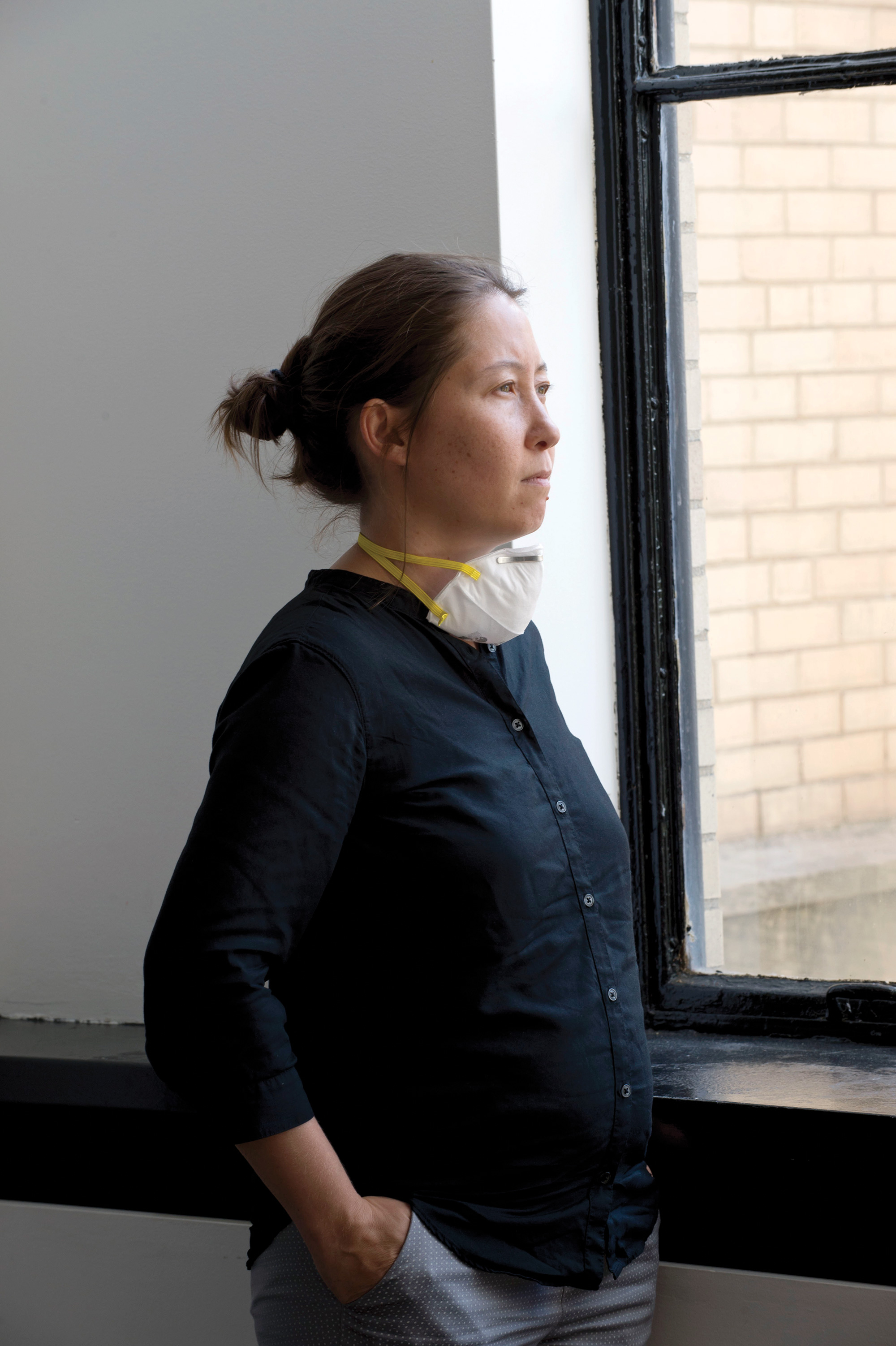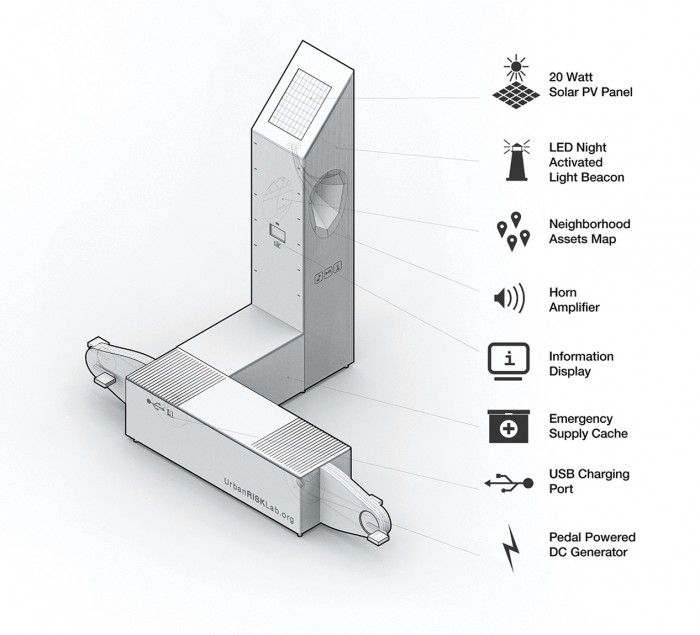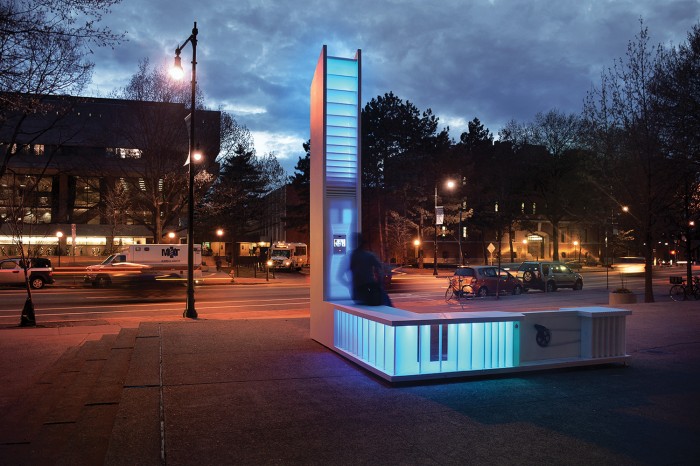Preparing for the Worst

The sleek white structure in the lobby of MIT’s Urban Risk Lab in building N52 could be a piece of public art or modernist playground equipment. Miho Mazereeuw, the assistant professor of architecture and urbanism who founded the lab in 2012, sits on a low bench and uses her feet to begin spinning a set of bicycle pedals mounted at one end. If she’d plugged her phone into the structure, she explains, a blue lighted bar on a nearby panel would display rainbow colors after a few minutes of pedaling, indicating that enough charge had been added to make several emergency calls. Additional pedaling helps charge both the phone and the battery inside the structure. “When kids ride it, the battery’s almost always full,” she says, laughing.
The prototype, called PrepHub, has other features that make it a helpful addition to an urban public space—a radio to play music, a local map, a touch screen with a camera for taking selfies. There’s little indication that the entire structure is, in fact, designed for disasters. In an emergency, the battery generator keeps devices functioning. The camera can help people document and send updates on their location. The radio becomes a conduit for public safety messages. The map can point out evacuation routes and shelters.
“As much as possible, we make everything dual function,” Mazereeuw says. When emergency technologies are embedded into everyday objects, they’re more likely to be used in a crisis.

With projects in the United States, India, Nepal, Peru, Japan, and other countries, the Urban Risk Lab has taken a broader vision of the role design can play in crises, modeling ways designers can think ahead to keep communities safe and resilient. “It’s design as activism, in a sense,” says David Moses, AR ’15, a research scientist who’s leading the PrepHub project.
Its work is interdisciplinary by nature, so the lab draws students from computer science, mechanical engineering, and other departments and collaborates with faculty in materials science and geophysics. For PrepHub, Mazereeuw’s team worked with engineers led by Adam Norige, an assistant group leader for the Humanitarian Assistance and Disaster Relief Systems Group at MIT’s Lincoln Laboratory. Norige, who is helping Mazereeuw teach a new class called Innovative Disaster Response and Preparedness this spring, says that while his team’s concern is developing technical capabilities, the Urban Risk Lab focuses on the “sunny day” uses of emergency technology. The lab deployed a PrepHub prototype on MIT’s campus in 2016; San Francisco got its first PrepHub in 2015 and will get a second in 2017. A long-term goal is to work with San Francisco’s Department of Emergency Management to pilot an interconnected network of these hubs in public spaces in the city.
In some ways, Mazereeuw’s interests are rooted in her personal background. She’s half Dutch and half Japanese, and a peripatetic life has given her an international perspective—she grew up in Malaysia, Korea, and Singapore and has worked or studied in the United States, Canada, Japan, and the Netherlands. Her childhood memories of Kuala Lumpur, which was undergoing explosive development, sparked an interest in the risks faced by rapidly urbanizing regions. And in 1995, while she was a student at Wesleyan University in Connecticut, a major earthquake struck Kobe, Japan, where her parents were in the process of moving. They were in Kuala Lumpur at the time, but her father’s office was leveled. When she visited Kobe a few months later, Mazereeuw was struck by the very different ways people were responding to the disaster, and she began gathering information and conducting interviews.
While completing master’s degrees in architecture and landscape architecture at the Harvard Graduate School of Design, she worked on a thesis that was the intellectual precursor of PrepHub, proposing dual-purpose infrastructure near subway stations as a way to provide emergency services. After graduating in 2002, she worked in architecture firms including the Office for Metropolitan Architecture in Rotterdam, led by the renowned architect Rem Koolhaas. But she was drawn to research and teaching. After teaching at the University of Toronto, she won a Wheelwright Traveling Fellowship from Harvard in 2007 to study three cities—including Kobe—in the earthquake-prone zone known as the Pacific Ring of Fire. Ultimately, Mazereeuw decided to remain in academia to share her ideas, first teaching at Harvard before moving to MIT to launch the Urban Risk Lab.
While personal experiences undoubtedly fueled her interest in disaster response, Mazereeuw believes it’s a topic that everyone should be concerned with. And while urban infrastructure plays a major role in disasters, she says most architecture schools don’t seem to pay serious attention to disaster preparedness and recovery. “It seems surprising to me that our profession doesn’t get more involved in this kind of research,” she says.
There’s a cyclical pattern to disaster response. The immediate aftermath of an event sees the most attention and funding, Mazereeuw says. But after that comes a longer rebuilding and recovery period, and eventually a process of preparing for the next disaster. The Urban Risk Lab focuses on the rebuilding and preparation stages. That’s also the time when citizens are least likely to care about disasters, and governments least willing to invest—and another reason for the lab’s multipurpose approach.

In 2016 the lab won an MIT IDEAS Global Challenge grant to apply the PrepHub concept to Nepal, where water sanitation is a key issue not only in disasters but also in day-to-day life. Rather than building standalone hubs, the researchers are focusing on strengthening existing community spaces: shelters called paatis, which are small public pavilions that serve as gathering sites in the Kathmandu Valley, with many offering public access to drinking water. “There is a community that’s already caring for them, so the kind of social structure that we’re looking for already exists,” she explains.
Partnering with a nongovernmental organization called Lumanti, they have spent time testing water samples for contamination and meeting with local communities. The goal of the project is not only to preserve paatis but to help them evolve by incorporating new technologies like water filtration systems and communication technologies.
When emergency technologies are embedded into everyday objects, they’re more likely to be used in a crisis.
A multiyear project in Shizugawa, Japan, has focused on planning and design workshops with local residents around tsunami recovery, resulting in new master plans and a community shelter. The lab has also worked with the World Bank on a project to evaluate evacuation systems in Haiti. And research scientist Aditya Barve, SM ’13, and research associate Mayank Ojha, SM ’16, are leading a project with support from the Tata Center for Technology and Design to improve affordable housing in India, which is facing a massive housing crisis as its population expands and grows more urban; currently millions of Indians live in unregulated, overcrowded settlements that lack clean water and durable shelter. Government-built housing is often constructed to replace these slums, but the cookie-cutter apartment towers don’t allow residents to set up stores and workshops to supplement their income, or expand their living space if their families grow. Housing that doesn’t serve a community well could leave people economically and socially vulnerable. Barve and Ojha are developing a decision-support system for planning housing projects with the help of data that local governments have collected about residents, such as their socioeconomic status and family size. Their proposed system of modularly designed housing could provide both the durability of a housing project and the customization of a self-built settlement.
Ojha, like many of the lab’s members, opted not to join an urban design firm in order to do work that could have a broader impact. Mazereeuw, he says, puts an emphasis on outreach. “We love this hands-on approach—getting out there, doing surveys, and doing a lot of prototyping with the stakeholders we have,” he says. The lab’s projects begin with extensive time on location. “In all of our research, we have local partners,” says Mazereeuw, who has worked hard to win funding to send lab members and students to locations around the globe for opportunities to learn from different contexts and cultures. She also brings the lab’s approach into the curriculum, co-teaching a class that asks students to research and design projects for environmentally vulnerable areas (this year’s class focused on South Florida).
In her own travels, Mazereeuw has gathered case studies on how communities around the world respond to and prepare for disasters; she’s currently working on a book that documents such efforts in countries that are part of the Pacific Ring of Fire, where most of the world’s earthquakes occur. While her preoccupation with disasters and crises used to puzzle her colleagues, growing concerns about the hazards of climate change have helped bring more people around to her way of seeing the world. “Now I feel that it’s a more common language,” she says, “but it’s still a lot of investment for cities for the ‘what if.’” That’s why the lab’s approach to design may offer lessons for dealing with climate change: prepare for an uncertain future by enhancing the everyday.
Keep Reading
Most Popular
Large language models can do jaw-dropping things. But nobody knows exactly why.
And that's a problem. Figuring it out is one of the biggest scientific puzzles of our time and a crucial step towards controlling more powerful future models.
The problem with plug-in hybrids? Their drivers.
Plug-in hybrids are often sold as a transition to EVs, but new data from Europe shows we’re still underestimating the emissions they produce.
Google DeepMind’s new generative model makes Super Mario–like games from scratch
Genie learns how to control games by watching hours and hours of video. It could help train next-gen robots too.
How scientists traced a mysterious covid case back to six toilets
When wastewater surveillance turns into a hunt for a single infected individual, the ethics get tricky.
Stay connected
Get the latest updates from
MIT Technology Review
Discover special offers, top stories, upcoming events, and more.